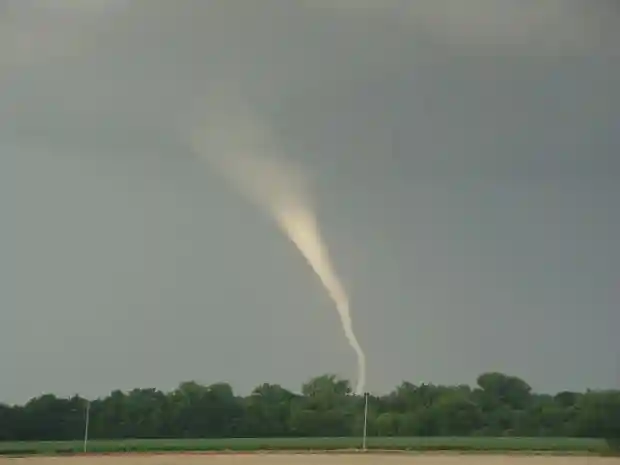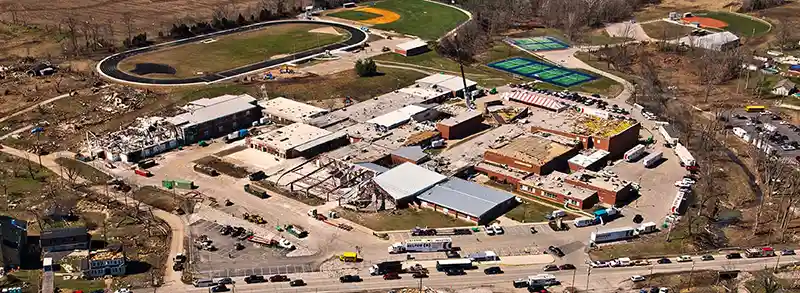Tornado Preparedness
To be ready for a tornado, you need to know what to do before, during, and after a tornado hits.

How To Prepare For A Tornado
Step 1: Plan
To protect your property, your family, and yourself during a tornado, it’s useful to develop a plan before the tornado hits. Make sure everyone is familiar with this plan.
As part of the plan, gather contact information and important documents in one place.
Contact information: You should record contact information for:
- Family members – personal cell phones
- Workplaces
- Schools
- Babysitters
- Utility companies
- Any other relevant contact details (such as family friends)
By recording all of these, you can contact friends, family members, and other important people at any time.
Important documents: Your plan should contain copies of:
- Birth certificates
- Social security cards
- Insurance policies
- Photos of your property, for insurance purposes
These documents will be vital if you need to evacuate the area or file an insurance claim following a tornado.
You should also create multiple evacuation plans, in case you need to leave the area and one route is not accessible.
Step 2: Build an emergency kit
The second step to preparing for a tornado is to make an emergency kit. Emergency kits are helpful in the event you lose power or other utilities, get injured, or become trapped. An emergency kit should include:
- Enough water and food for at least three days per person
- A device for communication (such as a radio)
- First aid supplies
- Spare clothes
- Flashlights
- Batteries
- Toiletries
- Maps of the local area
- Medications
How many supplies you need depends on the size of your family. Be sure to pay extra attention to any special circumstances within your family; any infants, medical conditions, or pets will require extra resources. Take all this into account when preparing your emergency kit.
Step 3: Identify shelter areas, or build a safe room
Another way to prepare for a tornado and stay safe when a tornado hits is to identify or build a safe place in your home to take shelter. Your shelter area or safe room should:
- Be on the lowest floor
- Have no windows
- Be as close to the center of the building as possible
- Contain your emergency kit
For these reasons, basements tend to make good shelter areas. If you don’t have a basement, a centrally located bathroom or closet also works.
When the tornado hits, you might not be at home, so identify other safe buildings and tornado shelters in the area, too, such as offices, schools, or town halls.
If you’re interested in building a safe room, the Federal Emergency Management Agency (FEMA) has specific recommendations and criteria to follow. Visit FEMA’s Safe Room FAQ page to learn more.
How Are Tornadoes Categorized?
Tornadoes are categorized using three main scales: The Fujita Scale, the Enhanced Fujita Scale, and the TORRO scale.
The Fujita Scale ranks tornadoes as F0, F1, F2, F3, F4 or F5. F0 is the weakest; F5 is the strongest. An F0 tornado means minor damage, such as branches ripped off trees. An F5 tornado lifts houses from their foundations and carries them through the air.
The Enhanced Fujita Scale uses a similar scale to the Fujita Scale – EF0, EF1, EF2, EF3, EF4 and EF5 – but it’s designed to provide a better assessment of tornado damage.
The TORRO scale ranks tornadoes between 0 and 11. It’s different to the Fujita Scales in that it only uses wind speed to categorize tornadoes, whereas the Fujita Scales take the extent of damage into account as well.
The United States uses the Enhanced Fujita Scale to categorize tornadoes. It replaced the Fujita Scale in 2007. Canada adopted the Enhanced Fujita Scale in 2013.
When Is Tornado Season? And Which States Get The Most Tornadoes?
Although tornadoes can hit at any time, the highest concentration typically occurs between March and May. These months are known as “tornado season.” However, this timing shifts based on region. Check out our When is Tornado Season? guide for more information.
Tornadoes can also occur anywhere, but some U.S. states are hit more frequently than others, which is why you've likely heard about "tornado alley." For more information about tornado alley, and the newer "dixie alley," check out our Where is Tornado Alley? guide.
How To Stay Safe During A Tornado
When a tornado hits, head for the lowest floor of the building. Find an interior room – one that isn’t connected to the front door of the building – with thick walls and no windows. If there’s a heavy table or desk, it’s a good idea to take shelter under it.
If possible, look for something to protect your head, such as a helmet. Cover the back of your head with your arms to protect it from debris.
If you’re in a mobile home, it’s best to reach a more secure building. Most injuries and fatalities from tornadoes happen in mobile homes.
Don’t open any windows. There’s a myth that the pressure drop from a tornado can cause a house to explode and opening windows can prevent this. In reality, the pressure drop won’t cause a house to explode, but letting the tornado-force wind inside through the windows can cause the roof to be lifted off your house.
If you can’t get into a building in time, move away from trees and cars. Lie down as flat on the ground as you can, and hold onto something secure. If you can, find a ditch or other low ground to lie down in until the tornado passes.
What To Do After A Tornado

Once the tornado has passed, there are several things you need to do, particularly if the tornado caused a lot of damage.
- Evacuate the immediate area - Don’t return until you’re told it’s safe. This allows emergency services to get to work unimpeded.
- Look for others - See if there are any injured people around you, but don’t put yourself in further danger to search for others. If you find anyone injured, call for help and contact emergency services ASAP.
- Contact friends and family members - Using the emergency contact list you created as part of your tornado plan, get in touch with family members and friends. Let them know you’re safe, and make sure they are too.
- Get the latest updates - Find a radio or TV and tune into local stations to hear the latest updates on safety and weather conditions.
- Check your property and understand the hazards - A tornado can damage your property in ways that make it hazardous. Gas leaks, electrical damage, or sewage leaks are all possible. If you notice or suspect any of these hazards after a tornado, contact your utilities company and emergency personnel immediately.
- Take pictures - Once your home has been deemed safe to return to, take photos of any damage. Documenting the damage caused will be useful when making insurance claims, especially if you have “before” photos of the damage as well.
Restoring Your Property
Once you’ve helped the injured and checked for immediate dangers on your property, consider getting in touch with your insurer to make a claim.
If there’s significant damage to your property, you could contact a professional disaster recovery or property restoration service.

